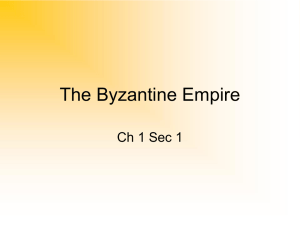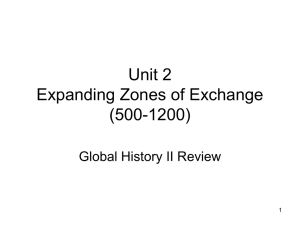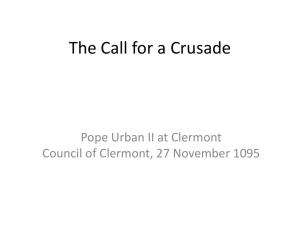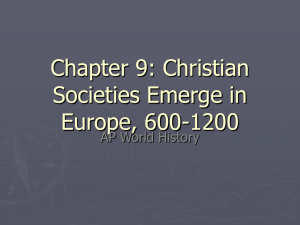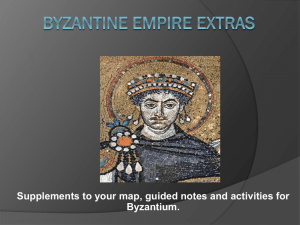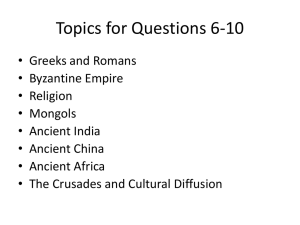Chapter 9: Emerging Europe and The Byzantine Empire
advertisement
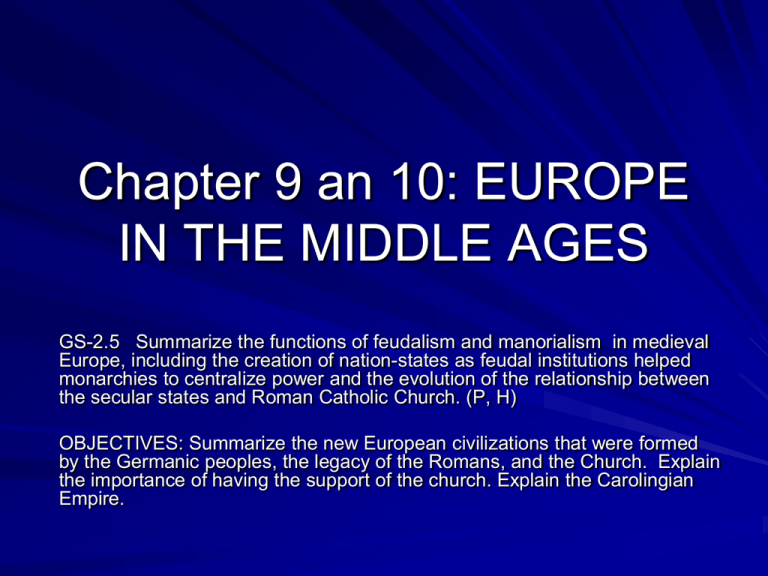
Chapter 9 an 10: EUROPE IN THE MIDDLE AGES GS-2.5 Summarize the functions of feudalism and manorialism in medieval Europe, including the creation of nation-states as feudal institutions helped monarchies to centralize power and the evolution of the relationship between the secular states and Roman Catholic Church. (P, H) OBJECTIVES: Summarize the new European civilizations that were formed by the Germanic peoples, the legacy of the Romans, and the Church. Explain the importance of having the support of the church. Explain the Carolingian Empire. Transforming the Roman World Section 1 Germanic Kingdoms Visigoths and Ostrogoths – Spain and Italy – Roman structure of government – Warrior class showing increasing dominance Angles and Saxons – Emigrated from Denmark to Britain Franks – France, Belgium, and Holland – Clovis – first Germanic ruler to convert to Christianity http://www.history.com/topics/clovis-i/videos#darkages-the-franks---clovis-part-i http://www.history.com/videos/dark-ages-thefranks---clovis-part-2#dark-ages-the-franks---clovispart-2 Germanic Society Germans and Romans intermarried and created a new society Family basic unit of society, very important Breaking a law was seen as an attack on the person, as opposed to an attack on the state Wergild – fine system Ordeal – “trial” Ordeal The Role of Church 4th Century – Christianity supreme religion of Europe Organization – Parish/Priest – Bishopric/Diocese/Bishop Rise of the Pope – Bishop of Rome – Claimed to have control over all other clergy – Gregory I Monastic Life Monks – Saint Benedict – Dedicate life to church – Communal living in monastery, headed by an abbot – Emphasis on labor and prayer – Life of poverty and doing charity Women in the Church – Nuns/Abbesses The Franks & The Rise of Charlemagne Charles Martel – Defeats Muslims at Battle of Tours, 732 – Son, Pepin, takes the throne – Charles, son of Pepin, expands Frankish kingdom, assumes name “Charlemagne” or “Charles the Great” The Carolingian Empire Emperor of the Romans Intellectual Revival FEUDALISM Section 2 Objective: Analyze how the Viking, Magyars, and Muslims invaded Europe during the ninth and tenth centuries. Critique the collapse of the central authority in the European world that led to a new political system known as feudalism. Summarize the rise of European Kingdoms and feudalism Describe key characteristics of each kingdom. New Invasion 9th/10th century Magyars – Migrated from Asia to Hungary Vikings – Germanic people, Scandinavia – Normandy Feudalism Increased need for protection – Centralized government inefficient – Commoners going to powerful warlords for protection in return for service Vassalage – Warriors swore and oath to a lord to serve them militarily – Lords took care of warriors needs (food, shelter, clothing, etc.) by granting a fief. – Warrior became a vassal of the Lord. Feudal Society Rise of the Knight class – Amored cavalry – Granted a fief for his service – Backbone of aristocracy The Feudal Contract – Unwritten social rules determining the relationship between people. KING (LORD) KNIGHTS (WARRIOR CLASS) PEASANTS/SERFS Nobility Ruling class Large land owners Chivalry – Code of ethics guide-lining behavior – Emphasis on honor, fighting for glory, not personal gain Tournament New roles for women – Managing castles – Propelled chivalry forward Early Medieval Castle - UK Tapestry Depicting Tournament French Noblewomen The Growth of European Kingdoms Objectives: Summarize the rise of European Monarchies and their quest to extend power and build strong states. Describe key characteristics of each monarchy England Angles and Saxons The Norman Conquest – William of Normandy – The Battle of Hastings, 1066 Henry II and Eleanor of Aquitaine – Common law – Power over Church Bayeaux Tapestry, Depicting Battle of Hastings Magna Carta & Parliament Magna Carta – Runnymede, 1215 – King John forced to recognize that power of the monarch was limited The Rise of Parliament – Edward I – House of Commons - 2 knights from every county, 2 people from every town – House of LordsAll nobles and bishops France Carolingian Empire divided; Kingdom of France established 843 Capetian Dynasty – Weak Kings – Authority over Paris only Phillip IV “The Fair” – Expansion of territory – 1302- Establishment of a Parliament, Estates-General The Holy Roman Empire Otto I Swore to protect the pope, Crowned ‘Emperor of the Romans” Germany and Italy Relatively weak office, as the areas were never consolidated into a single monarchy Russia Migration of Slavs, Swedish Vikings into Rus Establishment of Kiev empire 13th Century, Mongolian invasion Mongols driven out in 1242 – Alexander Nevsky – Established capital at Moscow The Byzantine Empire and the Crusades Section 4 Objective:Explain the rise and fall of the Byzantine Empire. Identify the key reasons for the fall or end to feudalism. Summarize the crusades impact on Medieval society in both the East and the West. Justinian Emperor Justinian, 527-565 – Capital of Constantinople – Wanted to reestablish empire in the entire Mediterranean – Italy, Spain, North Africa, Asia Minor, Palestine and Syria – The Body of Civil LawCode of Roman laws based on imperial law in Eastern Roman Empire Became the basis for much of the legal system of Europe. From Eastern Roman Empire to Byzantine Empire After the death of Justinian the Eastern Roman Empire had too much territory to protect far from Constantinople. – Loses of Justinian’s territories to Germans and Muslims reduced Eastern empire Remaining lands in the Balkans and Asia Minor called the Byzantine Empire – Greek replaced Latin as language – Eastern Orthodox Church- Patriarch: appointed head of the Church Emperor was believed to have been chosen by god. His power absolute. Byzantine Empire Constantinople Largest medieval city – Population 100,000+ Great center of trade – The mid-point of trade between China and Western Europe – ivory, spices, jewelry, fur – Silk cloth became the cities most lucrative product Hippodrome- gladiator fights and chariot Hagia Sophia- the church of the holy Wisdom The Macedonia Dynasty Ruled 867-1081 – 10th and 11th century restored power to empire, but ambitious military leaders and aristocratic families led to downfall. Economic prosperity – Selling silk, metalworks Expansion – 1025 the byzantine empire was the largest it had been since the beginning Schism Split between the Eastern Orthodox Church and the Catholic Church of the West – 1054, Pope Leo IX and Patriarch Michael Cerularius, excommunicated each other 1071: Turkish troops defeat Byzantine forces, ending European rule of the empire. The Crusades Military expeditions to the Holy Lands to regain them from the Muslims from the 11th to the 13th centrury Began as help to Alexius I, Byzantine emperor, to keep Muslim Turks from invading Constantinople. Evolved into a quest to liberate Jerusalem from the “infidels” Council of Clermont – Urban II The Crusades, (con’t.) Crusading Armies – Knights – Religious Fervor – Adventure – Wealth First Crusade – French – Led by Pope Urban II who wanted to free Jerusalem from the Infidels- unbelievers/ Muslims – Captured Antioch, 1098; Jerusalem, 1099 – Established “crusader” states; Italian port cities will profit – By 1140’s Muslims attack The Crusades (con’t) Second Crusade – France and Germany – Failure 1184 – Saladin attacks and takes Jerusalem The Third Crusade – 1189 France, England, Germany – Richard I (England) negotiated free pass to Jerusalem for Christian pilgrims The Crusades (con’t) Fourth Crusade Pope Innocent III – Constantinople sacked, 1204 – Power of the Byzantine diminished The Children’s Crusade – 1212 Impacts of Crusades – Increased trade to Europe – Anti-Semitism – Weakened power of nobles; feudalism




